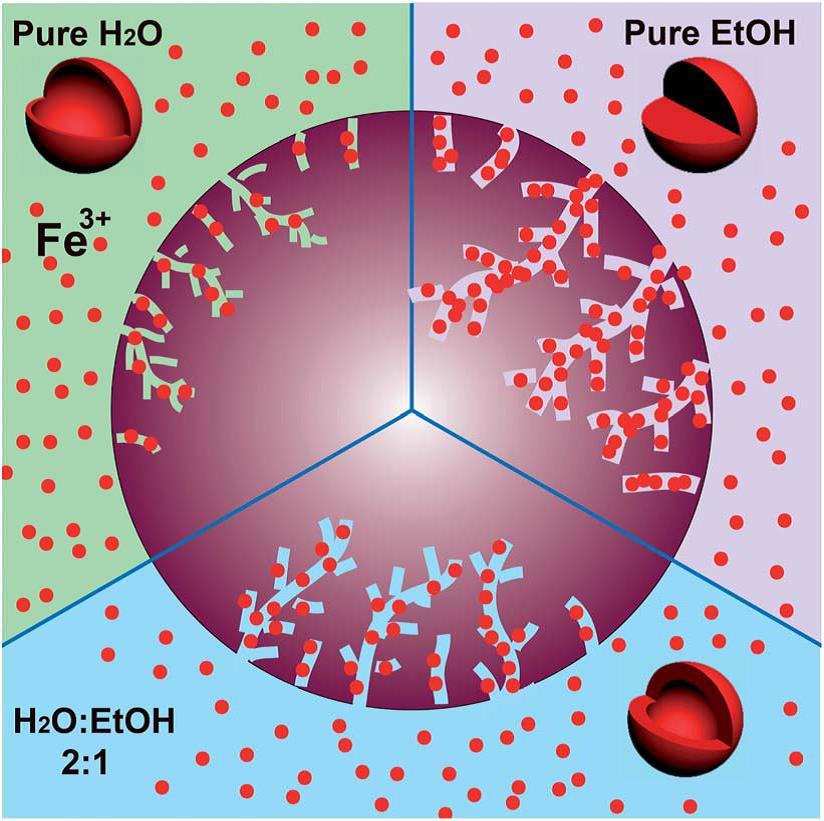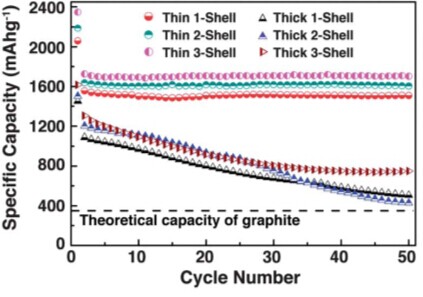α-Fe2O3 has the potential to replace graphite (372 mA h g-1) as the dominant anode material for commercial scale lithium storage due to its high theoretical capacity (~1000 mA h g-1), low toxicity, low cost, and high availability. However, it undergoes dramatic volume changes (~90%) upon cycling that causes anode pulverization and loss of electrical connectivity, which leads to poor capacity retention and limits commercial potential. Thin multi-shelled hollow microspheres have unique structural attributes that make them excellent candidates for high performance anode materials.
The research team led by Prof.Dan WANG at Institute of Process Engineering (IPE) of the Chinese Academy of Sciences had developed a facile method to produce hierarchical multi-shelled hollow microspheres composed of nanocrystal subunits using metal ion infused carbonaceous microspheres as sacrificial hard templates. By varying synthetic parameters, they had previously demonstrated control over the number of internal multi-shells and shell spacing for a variety of metal oxide multi-shelled hollow microspheres. (Angew. Chem. Int. Ed. 2011, 50, 2738-2741; Adv. Mater. 2012, 24, 1046-1049; Angew. Chem. Int. Ed. 2013, 52, 6417-6420)
Recently, Prof. Dan WANG and Prof. Ranbo YU from University of Science & Technology Beijing (USTB) further modify the strategy by tuning the Fe3+ concentration in the carbonaceous microsphere templates, which is controlled by the ethanol content of the aqueous infusion solution. Structural aspects including the shell thickness, number of internal multi-shells, and shell porosity of multi-shelled α-Fe2O3 hollow microspheres can be tailored, and the shell thickness had the most pronounced effect on capacity retention. As a result, thin triple-shelled α-Fe2O3 hollow microspheres showed remarkable lithium capacity and stable capacity retention up to 1702 mA h g-1 at current densities of 50 mA h g-1. The large specific surface area of the multi-shelled hollow spheres provides maximum lithium storage, while the porous thin shells facilitate rapid electrochemical kinetics and buffer mechanical stresses that accompany volume changes during de/lithiation. This work opens up opportunities for the development of environmentally friendly lithium ion batteries with high performance.
The results have been published on Energy. Environ. Sci.2014, 7, 632-637.


Figure 1. (a) Illustration showing that infusion solutions with increasing ethanol content enhance pore infiltration of Fe3+ in the carbonaceous microsphere templates; (b) Comparative cycling performance showing discharge capacities of thin and thick α-Fe2O3 multi-shelled hollow spheres at a current density of 50 mA h g-1.(Image by IPE)
 Search
Search




 京公网安备110402500047号
京公网安备110402500047号